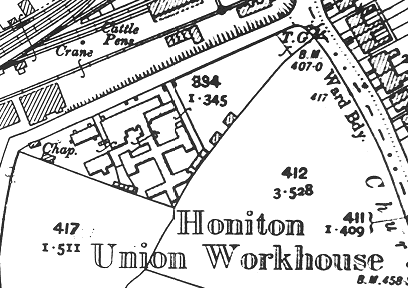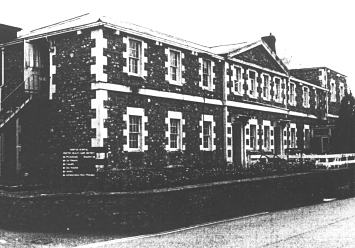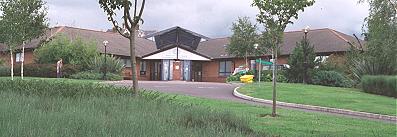Honiton, Devon
Up to 1834
A parliamentary report of 1776-7 recorded parish workhouses in operation at Honiton (for up to 60 inmates), Feniton (8), St Mary Ottery (100), Sidbury (40), and Sidmouth (20).
Sidmouth's workhouse stood near the ford at the north end of Mill Street. Northleigh's establishment was located where the village's Old School House now stands.
After 1834
Honiton Poor Law Union formally came into existence on 18th April 1836. Its operation was overseen by an elected Board of Guardians, 35 in number, representing its 28 constituent parishes as listed below (figures in brackets indicate numbers of Guardians if more than one):
County of Devon:Cotleigh, Dunkeswell, Farway, Feniton, Gittisham, Harpford, Honiton (3), Luppitt, Monkton, Northleigh, Offwell, Up Ottery, Venn Ottery, Ottery St Mary (2), Payhembury, Plymtree, Salcombe Regis, Sheldon, Sidbury (2), Sidmouth (3), Southleigh, Talaton, Widworthy.Later Addition: Yarcombe (from 1894).
The population falling within the Union at the 1831 census had been 22,330 with parishes ranging in size from Monkton (population 120) to Ottery St Mary (3,849) and Honiton itself (3,509). The average annual poor-rate expenditure for the period 1833-35 had been £10,244 or 9s.2d. per head of the population.
A new Union workhouse was built in 1836 at a site to the south of the present Honiton railway station. It was designed by George Wilkinson who was the architect of many other workhouse buildings although Honiton was his only in Devon. Its construction cost £5,322 and it could accommodate 200 inmates. The layout was based on the model cruciform or "square" design published by the Poor Law Commissioners in 1835. An entrance and administration block at the north contained a porter's room, offices and the Guardians' board-room. To the rear were four accommodation wings in the shape of a cross which provided segregated exercise yards for the different classes of inmates (male/female, infirm/able-bodied). Later additions included new sick wards in 1883 and other extensions in 1911. The workhouse location and layout are shown on the 1905 map below:

Honiton site, 1905

Honiton entrance block from the north-east.
In 1894, the British Medical Journal set up a "commission" to investigate conditions in provincial workhouses and their infirmaries. Following a visit to Honiton, the commission's report was broadly favourable but included a number of criticisms and recommendations. The low and narrow bedsteads in the sick wards were both uncomfortable for their occupants and increased the work of the nurses. There were no baths or bathrooms and any hot water required had to carried from the kitchen. The sole nurse, though long-serving, was neither trained nor a certified midwife. Further details are available in the full report.
The former Honiton workhouse later became Marlpits Hospital. The workhouse buildings were demolished in 1995 and a new hospital has been built on the site.

Honiton, 2000.
© Peter Higginbotham.
Staff
Inmates
Records
Note: many repositories impose a closure period of up to 100 years for records identifying individuals. Before travelling a long distance, always check that the records you want to consult will be available.
- Devon Heritage Centre, Great Moor House, Bittern Road, Sowton Exeter EX2 7NL. Very few records survive. Holdings include: Guardians' minute books (1894-6, 1905-1932); Boarding-out committee register (1904-32).
Bibliography
- None.
Links
Unless otherwise indicated, this page () is copyright Peter Higginbotham. Contents may not be reproduced without permission.


